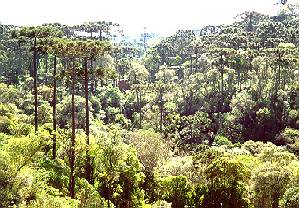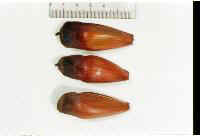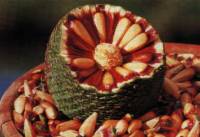
Respectively are fruit and nut of the Pine of Paraná or Brazilian Pine (araucaria
angustifolia).
MORPHOLOGY of the Araucaria angustifolia
A high tree, pantry of peculiar
format, imponent and characteristic figure, is frequent in the landscape of the south of
Brazil. The Araucaria angustifolia belongs to a small group, that encloses only two sorts:
the Agathis, natural of Australia, and the Araucaria, that appears on Chile, Argentina and
Brazil, and also in Australia and in the Norfolk islands. Although abundant in these
regions, the pine trees aren’t homogeneous as the European forests: the three appears
mixed to many other plants, as, for example, the imbuia, “erva-mate”, bamboos,
and diverse herb plants.
A tree of high bearing, with height
between 24 and 35 meters, hardly reach the 50 meters. With straight and cylindrical trunk
it possesses 1 to 2 meters of diameter, presenting thick, resinous, gray, wrinkled and
cracked bark. The twigs are long are lightly curved for top, with dense green-dark and
very acute leaves. When young, the plant possesses conical pantry and as it reaches
the adult age, takes the format of goblet or candelabrum, because of the natural fall of
the inferior dry branches.
Being a “dióica” species, the pine presents male units that produce
masculine flowers popularly called: “mingote”, “pinheco”,
“pichote”, finger, beyond other denominations and, femininas flowers,
“pinhas”, with approximately 20 centimeters of diameter, weighing 1 kg, contains
in average 120 seeds, or “pinhões”, being its spreading made by the man; by
birds like: “gralhas”, “maitacas”, parrots, “tirivas”,
as mammals as agoutis, rats, “préas”, “ouriços”,
“serelepes” and monkeys, guaranteeing the species perpetuation.
Of the 7.500.000 hectares of primitive forests of araucaria, in Paraná (state of
the south of Brazil) just 400.000 hectares remained.
Varied is the use of the pine, being able to affirm that everything of it is used to
advantage:
- The new pines are used as christmas trees;
- Due to its elegance and nobility of bear, it is used in the
scenery, mainly in gardens, squares and parks;
- They serve to demarcate verge in agricultural properties, too;
- Its wood is generally white, light and of multiple applications as in
the civil construction, folder mechanics, plated would, “movelaria”,
compensated, “caixaria”, sticks, cables of brooms, toys, musical instruments,
parquet blocks, wools and artificial silks;
- the twigs and rubbishes serve for firewood and fuels of boiler;
- The knots formed by the insertion of the twigs to the trunk, are used
as power plant and as raw material for artisan parts confection, for its durability,
attractive coloration and forms;
- The chemical resin can be used for acetone
manufacture,”terebentina”, varnishes and other products;
- The “pinhões”, are consumed by the man, and by domestic and wild
animals, being also able to be used in the alcohol manufacture. The indians of the south
of Brazil, food collectors, had the “pinhão”(nut), as the fruit par excellence,
acting as well as spreaders of the pines forests.
SCIENTIFIC SORTING
Kingdom: Vegetable.
Division: Gymnospermae.
Class: Coniferopsida.
Order: Coniferae.
Family: Araucariaceae.
Sort: Araucária.
Species: Araucaria angustifolia (Brazil) and Araucaria araucana (Argentina and Chile).
SYMBOLOGY of the Pinha-Pinhão Project
It can be made various analogies between the intentions of the Pinha-Pinhão Project and the Brazilian Pine or Pine of the Paraná:
PINHÃO:
 Pinhão is a nut. The
“pinhão” is a seed. Because it’s a seed, it is a potentiality. It locks up
inside of itself at the same time the past, the present and the future of the species. The
“pinhão” represents the individual that in it self possesses all the
inheritance of a past, the potentiality of the present and the possibility of the future.
In a “pinhão” exists an entire pine. It is a part that contains all. It
represents the force of the individuality.
Pinhão is a nut. The
“pinhão” is a seed. Because it’s a seed, it is a potentiality. It locks up
inside of itself at the same time the past, the present and the future of the species. The
“pinhão” represents the individual that in it self possesses all the
inheritance of a past, the potentiality of the present and the possibility of the future.
In a “pinhão” exists an entire pine. It is a part that contains all. It
represents the force of the individuality.
There are male and female
pines. A sex pine is barren without the presence of the other. In order to happen this
union, is of basic importance the presence of “polinizantes” ways, as the
wind and insects. The “pinhão” is resultant and only possible, with the
interaction of the male and female energy. The “pinhões”, thus produced, are
spreaded mainly by animals (“gralha azul”), that store “pinhões”, and
later on forget them on the ground. The “pinhão” represents the backing action
of the opposites, allied to the active presence of the nature as determinative force for
the man’s maintenance while species and as part of a whole.
PINHA:
 “Pinha” is flower/fruit
of the pine. It’s contains the seeds, the “pinhões”. It is a structure
that gives sustentation to the “pinhões” formation. It
possesses a central core for where all the “pinhões” are
guided and fixed (it represents a common goal that guides a lot of
the people ).
“Pinha” is flower/fruit
of the pine. It’s contains the seeds, the “pinhões”. It is a structure
that gives sustentation to the “pinhões” formation. It
possesses a central core for where all the “pinhões” are
guided and fixed (it represents a common goal that guides a lot of
the people ).
From this
central core, that is the part that connects with the pine, the “pinhões” are
nourished. Who looks at the exterior aspect of the “pinha”, has the impression
that all “pinhões” have equal format, and that isn’t verified when
the fruit is opened. All the group is formed by individuals that differ between
themselves, but, in a equal and cooperacional vision, the differences, while group, are
eliminated. “Pinha” represents the force of the group.
BRANCHES AND LEVES:
 “Pinhas” are fixed to the
branches. Branches, leaves and “pinhas” form a green set located on the top of
the twigs. This " green set " represents an intentional community. In it several
“pinhas” take shelter (groups of people). The groups are differed between
theirselves, but they form a unit when they are in a community. It is normal people who
congregate to live together, to possess goals in common, but divide themselves into small
groups to execute works or to chose a leisure: a consequence of the individuality of each
person. The set formed by “pinhas”, branches and leaves represents the
force of an intentional community.
“Pinhas” are fixed to the
branches. Branches, leaves and “pinhas” form a green set located on the top of
the twigs. This " green set " represents an intentional community. In it several
“pinhas” take shelter (groups of people). The groups are differed between
theirselves, but they form a unit when they are in a community. It is normal people who
congregate to live together, to possess goals in common, but divide themselves into small
groups to execute works or to chose a leisure: a consequence of the individuality of each
person. The set formed by “pinhas”, branches and leaves represents the
force of an intentional community.
TWIGS :
:
The twigs are structures of
sustentation of the different " green sets " (communities) and they connect
these last ones to the pine’s trunk. The consequence, visually, is that there is a
connection between the diverse " green sets" forming a "network of
intercommunication". The format of this "network of intercommunication" can
remind us the upper part of a chalice. The twigs and the set, now formed, represent the
union between the communities and its intercommunication (Internet).
TRUNK:
The Brazilian pine has a trunk that
is close to 50 meters of height and 2 meters of diameter. The trunk is a really important
structure that keeps the “chalice" nourished with water and minerals proceeding
from its deep roots. It represents a strengthened connection point between the sustenance
of the ground (the Mother Earth) and the cosmic energies picked-up by the
"chalice". This set can remind us about the “Graal” (the
“chalice” that Jesus drank in the last meal), symbol of the biggest objective of
the Alchemy: the personal transformation.
GROUND:
The pine grows in ground (south of
Brazil) where lives million of people of all the planet’s ethnics. A land of
people’s miscegenation (indians, africans, europeans and asians) that live in peace.
The ground represents the ideal of equality and peace between people, the force of the
globality.
The Pinha-Pinhão Project is taken
root in the vigor of the union of all the men who had exceeded to their differences and
look for, through the union and cooperation, to create a new society.
![]()
|
|